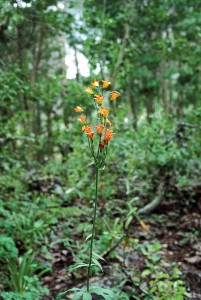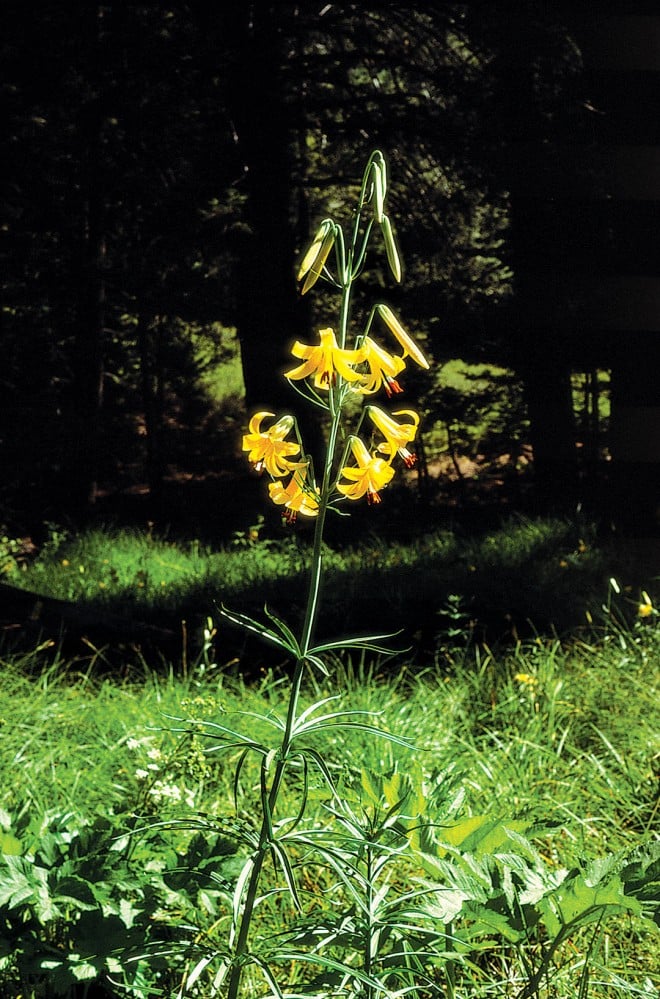
Burbank’s Hybrid West Coast Lilies

Contributor

Between 1875 and 1926, plant hybridizer Luther Burbank, uninhibited by then-current scientific opinion, made groundbreaking experiments on his farms in Santa Rosa and Sebastopol, California. He created many “impossible” hybrids and introduced close to 800 never-seen-before fruits and flowers. Among the most interesting and attractive results of his eagerness to “try everything” were hybrids created from the wild lilies of the West.
Burbank had pencil-underlined what he thought important in his copy of Notes on Lilies and Their Culture, by a Dr Wallace (New Plant and Bulb Company, Colchester, England, 1879), giving special attention to a section that listed the lilies of California, including Lilium washingtonianum, L. humboldtii, L. pardalinum, and L. parvum, plus four others whose names have since changed: L. bloomerianum (now L. humboldtii subsp. ocellatum), L. parviflorum (now L. columbianum), and L. canadense and L. californicum (both now L. humboldtii). Wallace commented on L. washingtonianum purpureum (now subsp. purpurascens), “or Eel River species, a very distinct form; flowers after being open for two or three days assuming a beautiful purple tint,” and on L. parryi, “allied to L. washingtonianum from Lower California and named after its discoverer Dr Parry.” Burbank inserted a penciled note on a scrap of paper: “is Parryi a cross of Wash and Pard?”

Lilies Draw Burbank West
Burbank began selling Pacific Coast native plant seeds and bulbs to the national and international nursery trade shortly after moving to Santa Rosa from Massachusetts in 1875. In his 1888 catalog, he described a “wild species of lily” (Lilium maritimum) as “California bog lily, dwarf, reddish orange, spotted.” In 1889, he offered leopard lily (L. pardalinum), a Turks cap with recurved, hardy, orange, reddish brown-spotted petals. In 1891, he added L. washingtonianum, with “very large, bold, thick white petals with large distinct spots, and very fragrant.”
To work with leopard lilies was one of the reasons he moved to California, Burbank said, and his first lily hybridizing experiments were with that species. In 1893, he introduced two Lilium pardalinum hybrids,
‘Hybrid P-2,854’, with large flowers, growing two feet high, and ‘Hybrid P-72,721’, growing only ten inches high and producing from twenty to forty blossoms on each of the short stalks—the usual number for the species being from three to eight.
He claimed he was too busy to keep records and never specified the other parents of these two hybrids.
Burbank eventually made crosses among most of the West’s native lilies: Lilium humboldtii; the yellow lemon lily (L. parryi), from California and Arizona; alpine lily (L. parvum), a species from the Sierra Nevada and Cascade ranges with outward- and upward-facing, trumpet-shaped flowers in shades of orange with a purple or maroon spotted throat on three- to five-foot stems; and Mt Hood or Shasta lily (L. washingtonianum), named for Martha Washington, not the state, growing from Yosemite Valley to the Canadian border. He also worked with non-native species in his hybridizing program, including the Asian L. sulphureum, a trumpet shaped, fragrant lily varying from ivory to sulphur yellow.
Fields of Lily Seedlings

Burbank had, at one time, 500,000 hybrid seedling lilies on two farms, he said, “one of them eight, the other ten miles by dusty roads” from Santa Rosa; three-quarters of them were crosses between Lilium pardalinum and as many species as he could get from around the world. He claimed he had the largest collection of hybrid lilies in the western United States.
Burbank cross-pollinated Lilium humboldtii and L. parryi to create a hybrid that grew four feet tall with open bell-shaped flowers, partially curved petals, brilliant yellow without spots, and a “delightful” fragrance. “The cross was made with some difficulty,” he said, “and the result was a lily which some connoisseurs have considered one of the most beautiful ever developed.”
A cross between Lilium pardalinum and L. parvum produced seedlings that multiplied with “astonishing rapidity” and had “hundreds of blossoms” on a single stem. Lilium parryi crossed with L. washingtonianum and L. pardalinum also “had extraordinary powers of multiplication” and grew to heights varying from two to ten feet. Notably, when the scentless L. pardalinum was crossed with L. washingtonianum, the hybrids looked like L. pardalinum but with an “exquisite fragrance.”
F F Rockwell, Esther C Grayson, and Jan de Graaf, in The Complete Book of Lilies (1961), said that Lilium pardalinum var. giganteum, known in the trade in 1960 as ‘Sunset’, ‘Red Giant’, and ‘Chinook Lily’, was actually Burbank’s cross between L. pardalinum and L. humboldtii. De Graaf, in his earlier The New Book of Lilies (1951), said the little trumpet-shaped lily named ‘Gold Cup’ in the trade “is definitely one of Burbank’s creations.” Plants could not be patented during Burbank’s lifetime, but, after his death, US patent #602 was granted to Laughlin and McCash for a yellow lily that they traced to Burbank seed.

Burbank and Carl Purdy
Burbank and Carl Purdy, who lived in Ukiah, fifty miles north of Santa Rosa, met in 1891, became good friends, and exchanged bulbs and plants whenever they could help each other. Purdy, a recognized expert on native California lilies, didn’t hybridize but gathered lilies and other bulbs on trips throughout Northern California and propagated them by the thousands for sale to Eastern and European nurserymen; one year he sold 5,000 Calochortus bulbs to John Lewis Childs, a Long Island nurseryman.
In 1895, Purdy wrote about Burbank’s lilies in Garden and Forest magazine:
His work with lilies began some eighteen years ago with a form of Lilium pardalinum found near the geysers, northeast of Santa Rosa. Extreme types of these seedlings were selected and cross-fertilized. The same process was repeated several times. Several years ago I saw a field of lilies, the result of this crossing and the variety was wonderful. Every intermediate form could be found. From plants nine feet tall to dwarfs from six inches to a foot in height, while the flowers ranged in color from yellow centers with scarlet tips through orange to light yellow centers with pale red tips. These variations, although variable in themselves, only formed a base for succeeding work, for when, by repeated cross fertilization, a form begins to break, it is more susceptible to the influence of the pollen of another species. Using these varieties of L. pardalinum as pistillate parents, Burbank crossed upon them many varieties of lilies, including other natives.
Four years ago, I saw the seed pans containing these hybrids, then a year from seed. The little plants, numbering four hundred thousand in all, made a wonderful study in leaf variation. These hybrids flowered last year and in the present season reached maturity. In the field, more than one hundred thousand hybrids were in bloom on the fifteenth of June; a small portion had not reached maturity. Among so large a number of hybrids, with so many violent crosses, freaks and monstrosities were to be expected, but outside of a few exceptions, it can be said that all are symmetrical in form and beautiful in coloring. In form, the range is from closely recurved of the L. pardalinum to a very flat flower, in which the petals approach the horizontal, a form, which as far as I know, was hitherto unknown in lilies. Practically all are fragrant, some exquisitely so. With a favorable wind, the odor from these great lily fields can be perceived at a distance of five miles.


Continuing to try everything, Burbank successfully crossed Lilium pardalinum with the West Coast native wakerobin (Trillium ovatum, placed in a related family, the Melanthiaceae, in Burbank’s time and now in the Trilliaceae). Seedlings were dwarfs and grew to resemble the lily’s foliage and the wake-robin’s blossom but could not be propagated despite Burbank’s best efforts.
George L Slate, in Lilies For American Gardens (1939), said, “What is probably the most extensive lily hybridizing project ever undertaken was started by the late Luther Burbank.” There is evidence that Burbank’s lily hybrids were planted widely in the United States and Europe, but most eventually died out, apparently succumbing to rot, thrips, aphids, or virus mosaic disease. In Luther Burbank’s Plant Contributions (University of California Bulletin #691, 1945), Dr Walter Howard, dean of UC’s College of Agriculture, said that if it had been known in 1894 how to combat virus mosaic disease, many of Burbank’s varieties “might have been spared to enrich our gardens.”

Bellingham Hybrids
Dr David Griffiths undertook the next large-scale lily breeding project in 1919 at the US. Department of Agriculture’s Bellingham, Washington, Bulb Experiment Station. Griffiths’s experiments began with hybrid lily seed he got from Carl Purdy, who had secured it from a “correspondent” whose name has been lost. Slate presumed the seed was from Lilium humboldtii pollinated by L. parryi and L. pardalinum; other experts suggested that it was the native L. humboldtii subsp. ocellatum, which has yellow-orange to golden orange flowers with prominent red spots, larger toward the tips.
From repeated generations of his lily seedlings, Griffiths selected seven plants, all with nodding flowers and reflexed, Turk’s cap-type petals; he kept good records and, under the aegis of the USDA, introduced them in 1924 as Griffiths Hybrids. Later, they became known as Bellingham Hybrids, and Rockwell, Grayson, and de Graaf referred to them as “ambassadors of beauty and goodwill, finding a welcome home in countries the world over. They have the vigor of the pioneers who made our country great. If we had made no other contribution to the world of lilies than just these hybrids, we could well rest on our laurels.”
While not the direct result of Burbank’s activities, it is not extravagant to assert that the popular Bellingham Hybrids were inspired by the pioneering work of the great plantsman. With his nearly legendary curiosity and energy, Burbank was the first to dive deeply into an investigation of the American West’s beautiful native lilies, the first to experiment with their potential.
Share:
Social Media
Garden Futurist Podcast
Most Popular
Videos
Topics
Related Posts

Low Maintenance Gardens – Better for Pollinators and People
Autumn 2022 “I come out every day. It’s therapy, my meditation.” Janet’s young garden transformed from overgrown, invasive plants to mostly natives. The dailiness of

Calochortophilia: A Californian’s Love Affair with a Genus
Summer 2022 I can chart the progression of my life by Calochortus. For the last two decades, at least. As a teenage girl growing up

Pacific Plant People: Carol Bornstein
Spring 2022 Public gardens play a key role in demonstrating naturalistic planting design, selecting native and adapted plants for habitat, and testing techniques for reducing

Add Year-Round Interest and Winter Blooms for Pollinators
Spring 2022 This article was created from an Interview by Merrill Jensen with Neil Bell in the Summer of 2021 for our Pacific Plant People










Responses